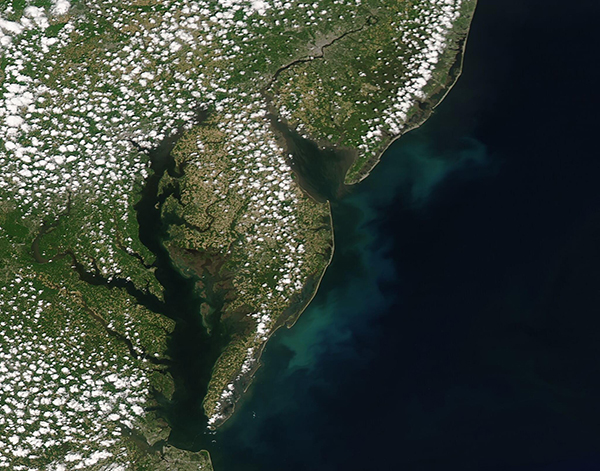Images
May 17, 2021 - Phytoplankton Bloom off of the Eastern United States
Tweet
A spring bloom of phytoplankton hugged the shores of Virginia, Maryland, Delaware, and New Jersey in mid-May 2021. The Moderate Resolution Imaging Spectroradiometer (MODIS) on board NASA’s Aqua satellite acquired an image of the bloom in the Atlantic Ocean on May 13. The jewel-toned swirls stretch along the coast for about 200 miles (322 km) and measure about 34 miles (55 km) wide.
Phytoplankton are tiny, plant-like organisms that often float near the ocean surface and turn sunlight and carbon dioxide into sugars and oxygen. In turn, they become food for the grazing zooplankton, shellfish, and finfish of the sea. The also play an important but not fully understood role in the global carbon cycle, taking carbon dioxide out of the atmosphere and sinking it to the bottom of the ocean.
These microscopic organisms live in these waters year-round, but usually their numbers are small enough that they aren’t visible. It’s only when conditions are right—warming waters, lengthening sunlight, and adequate nutrients—that they burst into the explosive reproduction which creates massive blooms easily seen from space.
On April 24, only three weeks before this image was acquired, a strong storm moved northeastward through the Mid-Atlantic states, carrying strong winds and torrential rains. By April 26, when the skies cleared, MODIS imagery revealed that the rivers as well as the waters of Delaware Bay (north) and the Chesapeake Bay (south) were mud-colored, indicating a large amount of sediment had washed into the two bays and, most likely, continued into the waters of the near-shore Atlantic. Although most of the sediment rapidly cleared from satellite imagery, it is likely that this rush of soil-laden water provided a burst of nutrients to spur phytoplankton growth.
Image Facts
Satellite:
Aqua
Date Acquired: 5/13/2021
Resolutions:
1km (231.9 KB), 500m (588.6 KB), 250m (431.4 KB)
Bands Used: 1,4,3
Image Credit:
MODIS Land Rapid Response Team, NASA GSFC
Tweet
A spring bloom of phytoplankton hugged the shores of Virginia, Maryland, Delaware, and New Jersey in mid-May 2021. The Moderate Resolution Imaging Spectroradiometer (MODIS) on board NASA’s Aqua satellite acquired an image of the bloom in the Atlantic Ocean on May 13. The jewel-toned swirls stretch along the coast for about 200 miles (322 km) and measure about 34 miles (55 km) wide.
Phytoplankton are tiny, plant-like organisms that often float near the ocean surface and turn sunlight and carbon dioxide into sugars and oxygen. In turn, they become food for the grazing zooplankton, shellfish, and finfish of the sea. The also play an important but not fully understood role in the global carbon cycle, taking carbon dioxide out of the atmosphere and sinking it to the bottom of the ocean.
These microscopic organisms live in these waters year-round, but usually their numbers are small enough that they aren’t visible. It’s only when conditions are right—warming waters, lengthening sunlight, and adequate nutrients—that they burst into the explosive reproduction which creates massive blooms easily seen from space.
On April 24, only three weeks before this image was acquired, a strong storm moved northeastward through the Mid-Atlantic states, carrying strong winds and torrential rains. By April 26, when the skies cleared, MODIS imagery revealed that the rivers as well as the waters of Delaware Bay (north) and the Chesapeake Bay (south) were mud-colored, indicating a large amount of sediment had washed into the two bays and, most likely, continued into the waters of the near-shore Atlantic. Although most of the sediment rapidly cleared from satellite imagery, it is likely that this rush of soil-laden water provided a burst of nutrients to spur phytoplankton growth.
Image Facts
Satellite:
Aqua
Date Acquired: 5/13/2021
Resolutions:
1km (231.9 KB), 500m (588.6 KB), 250m (431.4 KB)
Bands Used: 1,4,3
Image Credit:
MODIS Land Rapid Response Team, NASA GSFC




